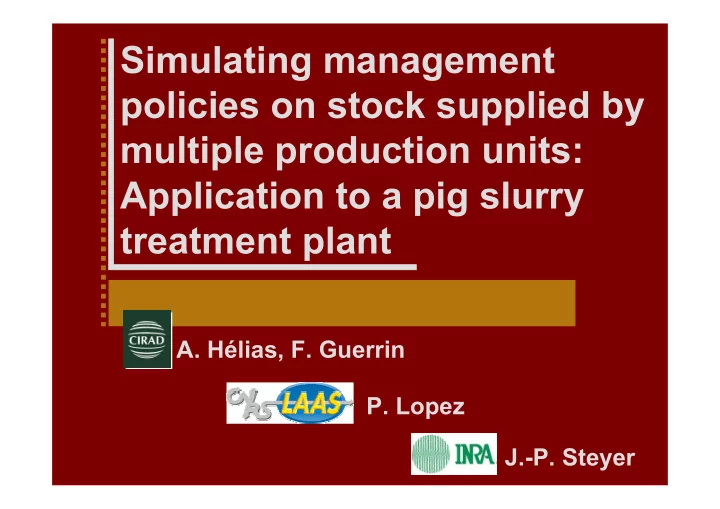

Simulating management policies on stock supplied by multiple production units: Application to a pig slurry treatment plant A. Hélias, F. Guerrin P. Lopez J.-P. Steyer
Introduction • Pig slurry: • An heterogeneous product with an important polluting capacity, • Development of intensive animal farming • Organic wastes surpluses • Treatment (regulation rules, environment)
Contents of presentation • Application background • Reunion Island distinctive features • System description • Supply policies • Model description • Block diagram representation • Stock evolutions • Transportation organization • Simulations • Specification of the scenarios • Comparison of supply policies
The case of Grand Ilet • Many small intensive animal farms • Slopes, rainfalls, urbanization, tourism... � limited area for spreading � limitation of transportation • Treatment required to transform slurry into an exportable product � A collective slurry treatment plant project part I: Application background
System description Supply policies Constraints Conveyor 1 Conveyor 1 Transport ... Organization Conveyor J Conveyor J CU PU 1 PU 1 Stock PU1 Delivery 11 Stock PU1 Delivery 11 ... Stock CU ... ... PU I PU I Stock PU I Stock PU I Delivery IJ Delivery IJ System limits part I: Application background
Slurry policies • “Who ?” and “When ?” mean “When should each production units perform a delivery?” • A fixed period basis: T policy • An alarm threshold: S policy • “How much ?” • A fixed quantity: Q policy • A variable quantity to move state back to a predetermined level: R policy T S Q T - Q S - Q R T - R S - R part I: Application background
Block Diagram production stocks PUs Current PUs model states conveyors Transport characteristics Organization Deliveries supply consumption stock CU Current policies CU model state part II: Model description
Hybrid dynamical system • Process: the continuous part • Stock evolutions (PUs and CU): volume and concentrations • Ordinary differential equations: mass balance equation • Transport organization: the discrete part • Transport actions (boolean) • Constraints part II: Model description
Stock evolutions • Ordinary differential equation: M N ∑ ∑ dV = − + Qin Qout Qover m n dt = = 1 1 m n = V ( 0 ) v 0 • with: M N M N ∑ ∑ ∑ ∑ − ≥ > Qin Qout if V v and Qin Qout = m n max m n Qover = = = = m 1 n 1 m 1 n 1 0 otherwise part II: Model description
Transport organization (1) • Mixed-integer linear program (branch & bound) • To each decision step • Objective function: ∑ ⋅ Max Pw i x ijk ijk • x ijk ∈ {0,1}: delivery k from PU i by conveyor j • Pw i ∈ [0,1]: cost accounting for a time delivery indicator in the case of policies T or S applied to the PU i part II: Model description
Transport organization (2) • Constraint's examples • PUs stock: ∑ ⋅ ≤ vc x Ph j ijk i jk • CU stock: ∑ ⋅ ≤ vc x P j ijk CU ijk • Conveyor cannot be at different places at the same time: ∑ ≤ 1 ∀ x j , k ijk i part II: Model description
Test scenarios • Stock Consumption Unit: 350 m 3 • 40 Production Units • A collective conveyor (10 m 3 ) • Scenario 1: • PUs policy: T-R (fixed date and emptying the stocks), • CU policy: Q (fixed quantity processed each day). • Scenario 2: • PUs policy: S-R (alarm threshold and emptying the stocks), • CU policy: R (refill the stock up to its limit capacity). part III: Simulations
Example 1 Stock evolution of the CU Policies: PUs � T-R, CU � Q 1 year Stock evolutions of the PUs max. mean � 1800 m 3 min. overflowing in the environment time (days) part III: Simulations
Example 2 Stock evolution of the CU Policies: PUs � S-R, CU � R 1 year Stock evolutions of the PUs max. � No slurry mean min. overflows to the environment time (days) part III: Simulations
Simulation’s result • Collective supply permits a better use of available resources. • Security increases with the CU stock capacity. • Usefulness of a closed-loop control: • CU policy: R, • PUs policy: S-R. � Increase reactivity to deal with stock limitations. part III: Simulations
Conclusion • A hybrid dynamical system: • Continuous part: Stock evolutions encoded as ODEs, • Discrete part: Transport organization as a MILP. • Application on the specific case of Grand Ilet: • Different policies and different parameter values, • Benefit of a closed-loop control. • Perspectives: • Generalize this approach by a generic production/consumption model • Application to other problems (individual farm, inter- farms transfers)
Recommend
More recommend